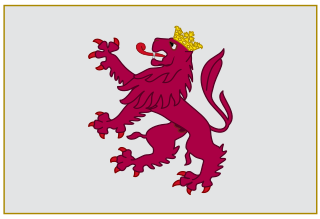
The Kingdom of León was an independent kingdom situated in the northwest region of the Iberian Peninsula. It was founded in 910 when the Christian princes of Asturias along the northern coast of the peninsula shifted their capital from Oviedo to the city of León. The kings of León fought civil wars, wars against neighbouring kingdoms, and campaigns to repel invasions by both the Moors and the Vikings, all in order to protect their kingdom's changing fortunes.

A Coruña is a city and municipality in Galicia, Spain. It is Galicia's second largest city, behind Vigo. The city is the provincial capital of the province of A Coruña, having also served as political capital of the Kingdom of Galicia from the 16th to the 19th centuries, and as a regional administrative centre between 1833 and 1982.
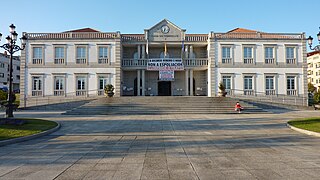
Salvaterra de Miño is a town and municipality (concello) in the province of Pontevedra, autonomous community of Galicia, Spain. It's located on the southern border of the province of Pontevedra, at the confluence of the valleys of the rivers Tea and Minho, and by the natural limits of the Serra da Cañiza. It borders the Municipalities of As Neves in the east, Mondariz and Poteareas to the north, and to the south by the Minno river. The Minno river is the southern natural border that today separates Portugal with its fortified town of Monção from current Galicia to the north.

Brión is a municipality in the province of A Coruña, in the autonomous community of Galicia in northwestern Spain. It belongs to the comarca of Santiago de Compostela and is 13 km to the east of Santiago de Compostela. It has an area of 74.9 square kilometres (28.9 sq mi), and a population of 7,519 inhabitants (2014).
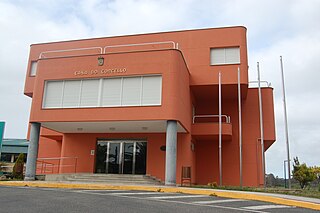
Cabana de Bergantiños or Cabana is a municipality in the Province of A Coruña, in the autonomous community of Galicia in northwestern Spain. It used to be known as Cesullas.

Cinfães is a village and a municipality in the northern district of Viseu, Portugal. The village proper has about 3,300 inhabitants. The population of the municipality in 2011 was 20,427, in an area of 239.29 km2.
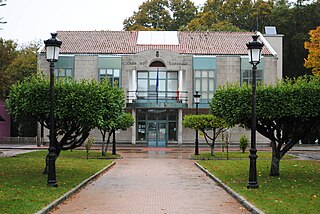
O Saviñao is a Concello (council) in the province of Lugo, Galicia belonging to the district of Terra de Lemos. The main town for the council is Escairón.

Oeste Towers is a castle in Catoira, Galicia, Spain. It is located at the head of the Ría de Arousa. It is in the region of Caldas (Pontevedra), in the river Ulla estuary. The towers remaining today are the ruins of Castellum Honesti. Torres del Oeste has been declared a national monument.
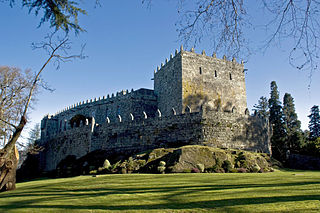
Pedro Álvarez de Soutomaior, known by the sobriquet Pedro Madruga, was a Galician nobleman and knight. He was a notable figure in Galicia where he exerted certain influence in the Portuguese court, as well as spending time in that of Castile. He was one of the leading lords who suppressed the Irmandiño peasant revolts in the 1460s, and also fought in favor of the Portuguese-backed claimant to the Castilian throne, Joanna la Beltraneja, in the War of the Castilian Succession.

Torre del Mar is a locality on the southern coast of Spain, in the municipality of Vélez-Málaga, Axarquía, located in the province of Málaga.
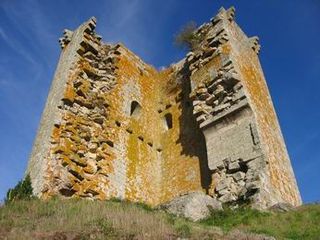
The Irmandiño revolts were two revolts that took place in the 15th-century Kingdom of Galicia against attempts by the regional nobility to maintain their rights over the peasantry and the bourgeoisie. The revolts were also part of the larger phenomenon of popular revolts in late medieval Europe caused by the general economic and demographic crises in Europe during the 14th and 15th centuries. Similar rebellions broke out in the Hispanic Kingdoms, including the War of the Remences in Catalonia and the foráneo revolts in the Balearic Islands.
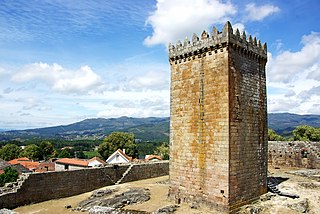
The Castle of Melgaço is located in Vila parish, Melgaço municipality, Viana do Castelo district, in Portugal.

An albarrana tower is a defensive tower detached from the curtain wall and connected to it by a bridge or an arcade. They were built by Muslims when they occupied the Iberian Peninsula between the 8th and the 15th centuries, especially from the 12th century during the Almohad dynasty and mainly in the south of Spain and Portugal where the Islamic influence was the longest. In Spanish, they are called torre albarrana.

The Castle of Mós is a medieval castle located in the civil parish of Mós, municipality of Torre de Moncorvo, in the Portuguese district of Bragança.

The Castle of Burgos was a castle and alcázar, located in the city of Burgos, in the hill of San Miguel to 75 metres (246 ft) above the city and to 981 metres (3,219 ft) above the sea. This hill was the subject of archaeological surveys by General Centeno in the years 1925 and 1926 trying to find Napoleonic military files from when the French in their retreat blew up the fortress. According to the results obtained in this excavation the origin of the castle dates to the Visigoths, and its oldest parts, to the Romans.
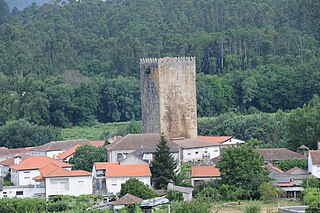
The Torre of Lapela is a ruined medieval castle located next to the Minho River in the town of Lapela, in Monção municipality, Viana do Castelo District, Portugal.

The Castle of Lindoso is a medieval castle in the civil parish of Lindoso, municipality of Ponte da Barca, in the Portuguese district of Viana do Castelo.

The Castle of Portel is a medieval castle located in the municipality of Portel in the district of Evora in Portugal.

The Archiepiscopal Towers Interpretation Centre (CITA)(Centro de Interpretación das Torres Arcebispais (CITA)) is a museum in Pontevedra, Spain created in 2010 in the former moat of the Archiepiscopal Towers fortress-palace in the old town. The museum focuses on the interpretation of what was one of the most important monuments and defensive structures of the city, the Archbishop's Towers, which were part of the Ramparts of Pontevedra.

The Castle of Monterrey is a 15th-century castle at Monterrei, in Ourense, Galicia. It is located at what was then a strategic point on the frontier between the kingdoms of Galicia and Portugal.



















